Abstract
BACKGROUND: Eicosanoids such as prostaglandin E2 (PGE2), thromboxane A2 (TXA2), and peptidoleukotrienes (pLT) are known to be biologically highly active lipid mediators, especially in human lung epithelium. PGE2 is thought to have mostly bronchoprotective effects, whereas pLT and TXA2 are bronchoconstrictive. This study was undertaken to assess the release and interaction of eicosanoids in human bronchial biopsy specimens of normal and inflamed mucosa. METHODS: Bronchial biopsy specimens were obtained from 16 patients, seven controls without signs of inflammation and nine patients with severe inflammatory processes in the epithelium. The release of pLT, TXA2 (measured as TXB2), and PGE2 was investigated using a "functional in vitro test" and the addition of several stimuli. RESULTS: Specimens incubated with arachidonic acid released higher amounts of pLT, TXB2, and PGE2 than unstimulated specimens. Preincubation with PGE2 revealed significant inhibition of arachidonic acid-induced release of pLT and TXB2 (> 50%). The inhibitory effect was higher in normal than in inflamed epithelium. CONCLUSIONS: Exogenous PGE2 has inhibitory effects on the release of pLT and TXB2 in human bronchial biopsy specimens. This finding could explain the bronchoprotective effect of inhaled PGE2 in normal subjects and asthmatic subjects as direct eicosanoid interactions. It also supports the concept of PGE2 as a bronchoprotective endogenous substance. The complex effects of PGE2 as a modulating mediator in inflammation may be worth investigating.
Full text
PDF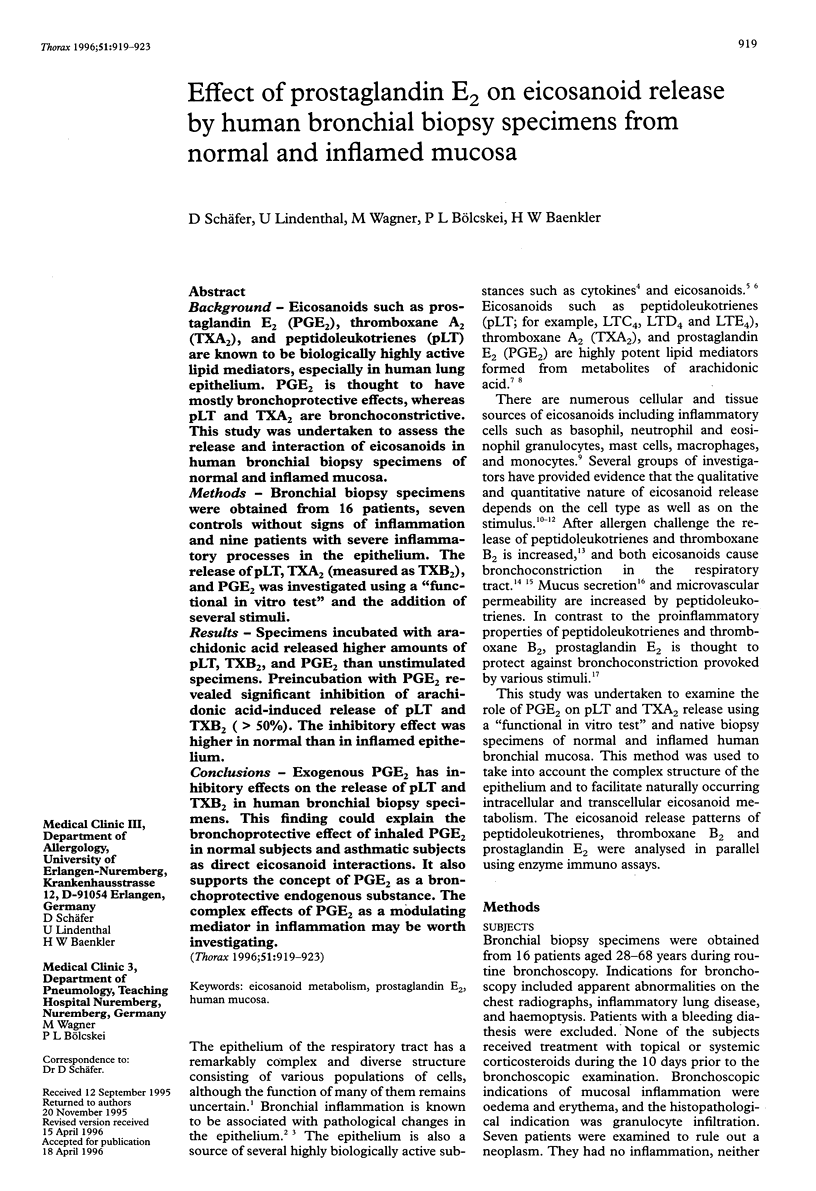
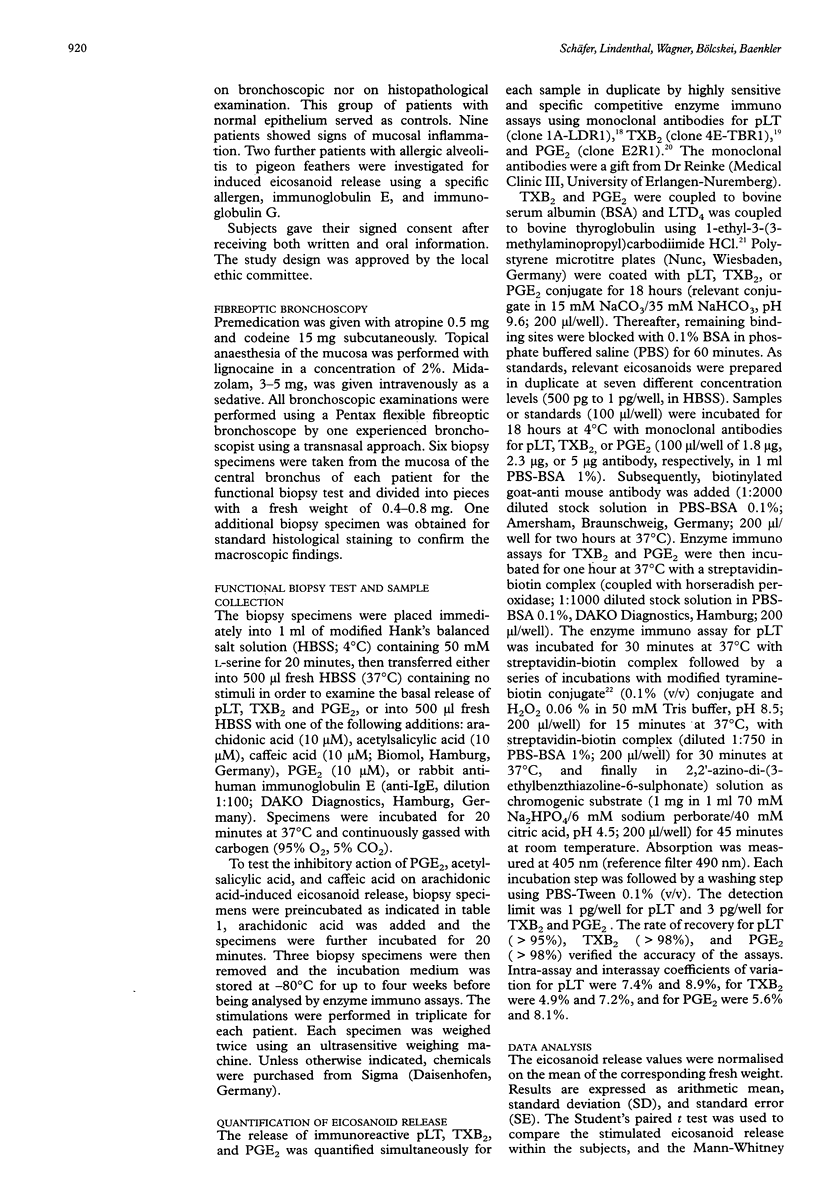
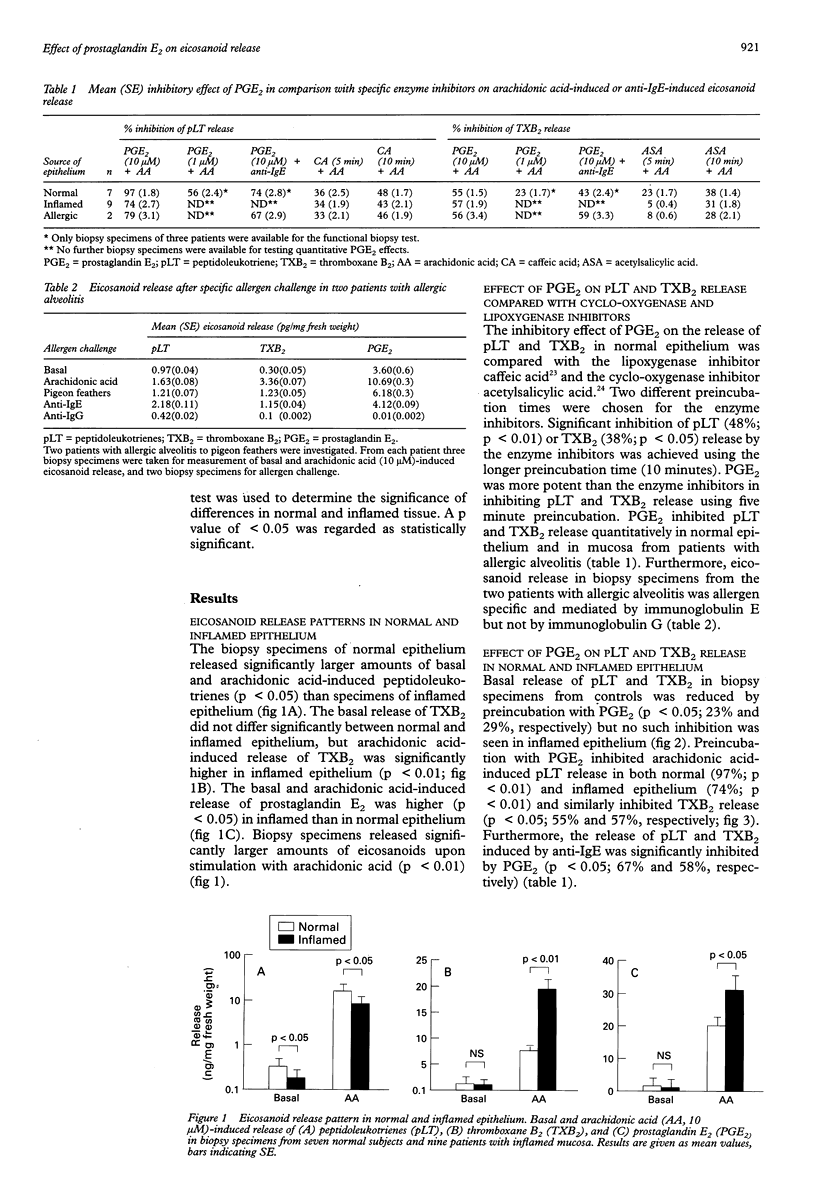
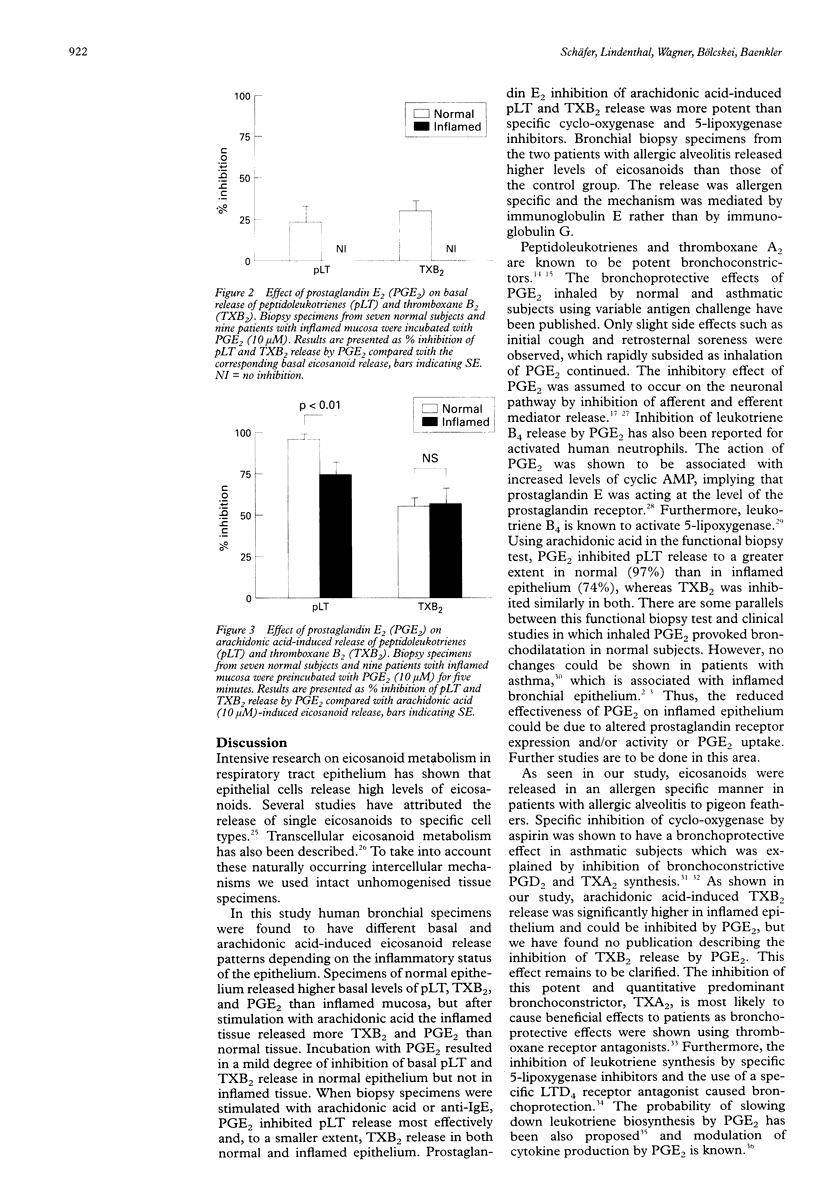
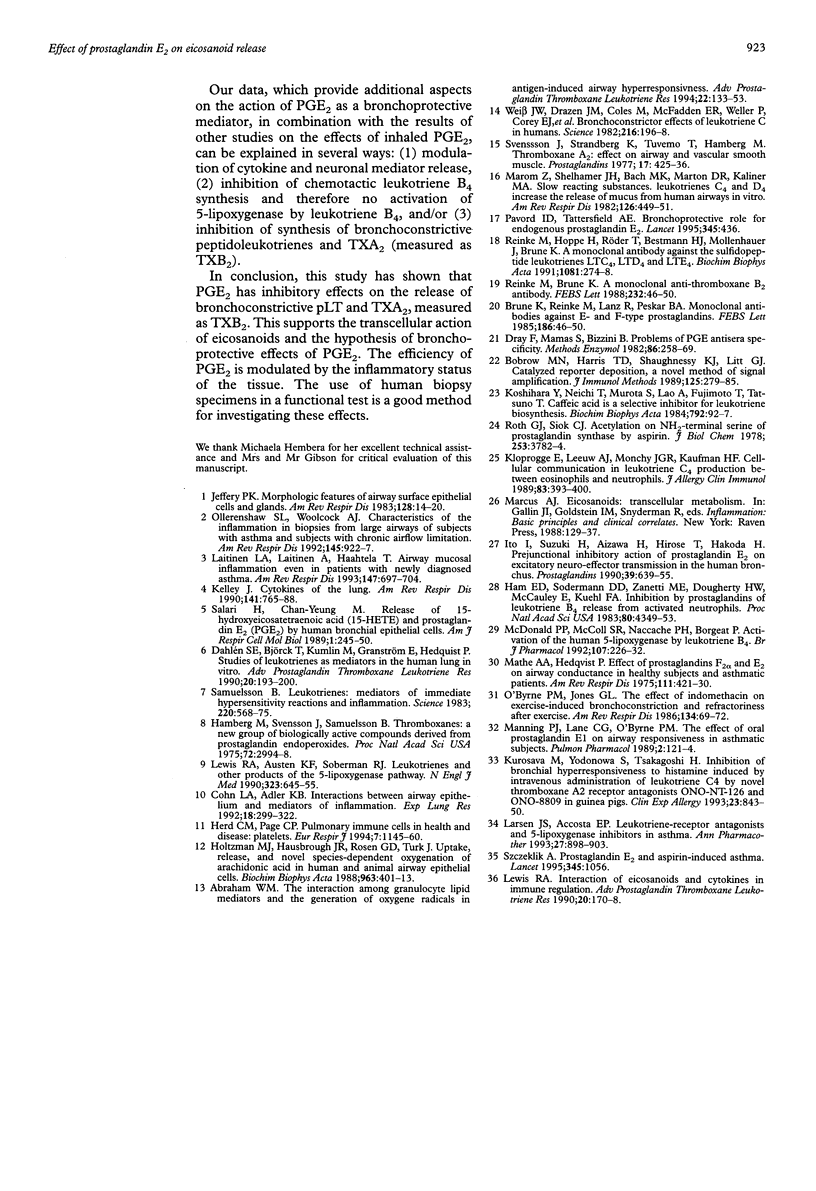
Selected References
These references are in PubMed. This may not be the complete list of references from this article.
- Bobrow M. N., Harris T. D., Shaughnessy K. J., Litt G. J. Catalyzed reporter deposition, a novel method of signal amplification. Application to immunoassays. J Immunol Methods. 1989 Dec 20;125(1-2):279–285. doi: 10.1016/0022-1759(89)90104-x. [DOI] [PubMed] [Google Scholar]
- Brune K., Reinke M., Lanz R., Peskar B. A. Monoclonal antibodies against E- and F-type prostaglandins. High specificity and sensitivity in conventional radioimmunoassays. FEBS Lett. 1985 Jul 1;186(1):46–50. doi: 10.1016/0014-5793(85)81336-3. [DOI] [PubMed] [Google Scholar]
- Cohn L. A., Adler K. B. Interactions between airway epithelium and mediators of inflammation. Exp Lung Res. 1992 May-Jun;18(3):299–322. doi: 10.3109/01902149209031687. [DOI] [PubMed] [Google Scholar]
- Dahlén S. E., Björck T., Kumlin M., Granström E., Hedqvist P. Studies of leukotrienes as mediators in the human lung in vitro. Adv Prostaglandin Thromboxane Leukot Res. 1990;20:193–200. [PubMed] [Google Scholar]
- Dray F., Mamas S., Bizzini B. Problems of PGE antisera specificity. Methods Enzymol. 1982;86:258–269. doi: 10.1016/0076-6879(82)86198-3. [DOI] [PubMed] [Google Scholar]
- Ham E. A., Soderman D. D., Zanetti M. E., Dougherty H. W., McCauley E., Kuehl F. A., Jr Inhibition by prostaglandins of leukotriene B4 release from activated neutrophils. Proc Natl Acad Sci U S A. 1983 Jul;80(14):4349–4353. doi: 10.1073/pnas.80.14.4349. [DOI] [PMC free article] [PubMed] [Google Scholar]
- Hamberg M., Svensson J., Samuelsson B. Thromboxanes: a new group of biologically active compounds derived from prostaglandin endoperoxides. Proc Natl Acad Sci U S A. 1975 Aug;72(8):2994–2998. doi: 10.1073/pnas.72.8.2994. [DOI] [PMC free article] [PubMed] [Google Scholar]
- Herd C. M., Page C. P. Pulmonary immune cells in health and disease: platelets. Eur Respir J. 1994 Jun;7(6):1145–1160. [PubMed] [Google Scholar]
- Holtzman M. J., Hansbrough J. R., Rosen G. D., Turk J. Uptake, release and novel species-dependent oxygenation of arachidonic acid in human and animal airway epithelial cells. Biochim Biophys Acta. 1988 Dec 16;963(3):401–413. doi: 10.1016/0005-2760(88)90308-6. [DOI] [PubMed] [Google Scholar]
- Ito I., Suzuki H., Aizawa H., Hirose T., Hakoda H. Pre-junctional inhibitory action of prostaglandin E2 on excitatory neuro-effector transmission in the human bronchus. Prostaglandins. 1990 Jun;39(6):639–655. doi: 10.1016/0090-6980(90)90024-p. [DOI] [PubMed] [Google Scholar]
- Kelley J. Cytokines of the lung. Am Rev Respir Dis. 1990 Mar;141(3):765–788. doi: 10.1164/ajrccm/141.3.765. [DOI] [PubMed] [Google Scholar]
- Kloprogge E., de Leeuw A. J., de Monchy J. G., Kauffman H. F. Hypodense eosinophilic granulocytes in normal individuals and patients with asthma: generation of hypodense cell populations in vitro. J Allergy Clin Immunol. 1989 Feb;83(2 Pt 1):393–400. doi: 10.1016/0091-6749(89)90124-3. [DOI] [PubMed] [Google Scholar]
- Koshihara Y., Neichi T., Murota S., Lao A., Fujimoto Y., Tatsuno T. Caffeic acid is a selective inhibitor for leukotriene biosynthesis. Biochim Biophys Acta. 1984 Jan 17;792(1):92–97. [PubMed] [Google Scholar]
- Kurosawa M., Yodonawa S., Tsukagoshi H. Inhibition of bronchial hyperresponsiveness to histamine induced by intravenous administration of leukotriene C4 by novel thromboxane A2 receptor antagonists ONO-NT-126 and ONO-8809 in guinea-pigs. Clin Exp Allergy. 1993 Oct;23(10):843–850. doi: 10.1111/j.1365-2222.1993.tb00262.x. [DOI] [PubMed] [Google Scholar]
- Laitinen L. A., Laitinen A., Haahtela T. Airway mucosal inflammation even in patients with newly diagnosed asthma. Am Rev Respir Dis. 1993 Mar;147(3):697–704. doi: 10.1164/ajrccm/147.3.697. [DOI] [PubMed] [Google Scholar]
- Larsen J. S., Acosta E. P. Leukotriene-receptor antagonists and 5-lipoxygenase inhibitors in asthma. Ann Pharmacother. 1993 Jul-Aug;27(7-8):898–903. doi: 10.1177/106002809302700718. [DOI] [PubMed] [Google Scholar]
- Lewis R. A., Austen K. F., Soberman R. J. Leukotrienes and other products of the 5-lipoxygenase pathway. Biochemistry and relation to pathobiology in human diseases. N Engl J Med. 1990 Sep 6;323(10):645–655. doi: 10.1056/NEJM199009063231006. [DOI] [PubMed] [Google Scholar]
- Lewis R. A. Interactions of eicosanoids and cytokines in immune regulation. Adv Prostaglandin Thromboxane Leukot Res. 1990;20:170–178. [PubMed] [Google Scholar]
- Manning P. J., Lane C. G., O'Byrne P. M. The effect of oral prostaglandin E1 on airway responsiveness in asthmatic subjects. Pulm Pharmacol. 1989;2(3):121–124. doi: 10.1016/0952-0600(89)90035-5. [DOI] [PubMed] [Google Scholar]
- Marom Z., Shelhamer J. H., Bach M. K., Morton D. R., Kaliner M. Slow-reacting substances, leukotrienes C4 and D4, increase the release of mucus from human airways in vitro. Am Rev Respir Dis. 1982 Sep;126(3):449–451. doi: 10.1164/arrd.1982.126.3.449. [DOI] [PubMed] [Google Scholar]
- McDonald P. P., McColl S. R., Naccache P. H., Borgeat P. Activation of the human neutrophil 5-lipoxygenase by leukotriene B4. Br J Pharmacol. 1992 Sep;107(1):226–232. doi: 10.1111/j.1476-5381.1992.tb14491.x. [DOI] [PMC free article] [PubMed] [Google Scholar]
- O'Byrne P. M., Jones G. L. The effect of indomethacin on exercise-induced bronchoconstriction and refractoriness after exercise. Am Rev Respir Dis. 1986 Jul;134(1):69–72. doi: 10.1164/arrd.1986.134.1.69. [DOI] [PubMed] [Google Scholar]
- Ollerenshaw S. L., Woolcock A. J. Characteristics of the inflammation in biopsies from large airways of subjects with asthma and subjects with chronic airflow limitation. Am Rev Respir Dis. 1992 Apr;145(4 Pt 1):922–927. doi: 10.1164/ajrccm/145.4_Pt_1.922. [DOI] [PubMed] [Google Scholar]
- Pavord I. D., Tattersfield A. E. Bronchoprotective role for endogenous prostaglandin E2. Lancet. 1995 Feb 18;345(8947):436–438. doi: 10.1016/s0140-6736(95)90409-3. [DOI] [PubMed] [Google Scholar]
- Reinke M., Brune K. A monoclonal anti-thromboxane B2 antibody. FEBS Lett. 1988 May 9;232(1):46–50. doi: 10.1016/0014-5793(88)80383-1. [DOI] [PubMed] [Google Scholar]
- Reinke M., Hoppe U., Röder T., Bestmann H. J., Mollenhauer J., Brune K. A monoclonal antibody against the sulfidopeptide leukotrienes LTC4, LTD4 and LTE4. Biochim Biophys Acta. 1991 Feb 5;1081(3):274–278. doi: 10.1016/0005-2760(91)90282-m. [DOI] [PubMed] [Google Scholar]
- Roth G. J., Siok C. J. Acetylation of the NH2-terminal serine of prostaglandin synthetase by aspirin. J Biol Chem. 1978 Jun 10;253(11):3782–3784. [PubMed] [Google Scholar]
- Salari H., Chan-Yeung M. Release of 15-hydroxyeicosatetraenoic acid (15-HETE) and prostaglandin E2 (PGE2) by cultured human bronchial epithelial cells. Am J Respir Cell Mol Biol. 1989 Sep;1(3):245–250. doi: 10.1165/ajrcmb/1.3.245. [DOI] [PubMed] [Google Scholar]
- Samuelsson B. Leukotrienes: mediators of immediate hypersensitivity reactions and inflammation. Science. 1983 May 6;220(4597):568–575. doi: 10.1126/science.6301011. [DOI] [PubMed] [Google Scholar]
- Svenssen J., Strandberg K., Tuvemo T., Hamberg M. Thromboxane A2: effects on airway and vascular smooth muscle. Prostaglandins. 1977 Sep;14(3):425–436. doi: 10.1016/0090-6980(77)90258-1. [DOI] [PubMed] [Google Scholar]
- Szczeklik A. Prostaglandin E2 and aspirin-induced asthma. Lancet. 1995 Apr 22;345(8956):1056–1056. doi: 10.1016/s0140-6736(95)90799-8. [DOI] [PubMed] [Google Scholar]
- Weiss J. W., Drazen J. M., Coles N., McFadden E. R., Jr, Weller P. F., Corey E. J., Lewis R. A., Austen K. F. Bronchoconstrictor effects of leukotriene C in humans. Science. 1982 Apr 9;216(4542):196–198. doi: 10.1126/science.7063880. [DOI] [PubMed] [Google Scholar]


